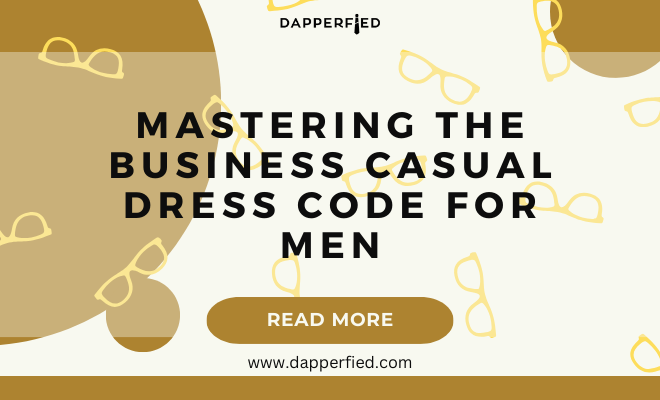
Men's Style
Mastering the Business Casual Dress Code for Men
Business casual is a dress code that is commonly used in professional settings. It is a step down from traditional business attire, such as suits and ties, but still requires a polished and put-together look. Understanding the business casual dress code is essential for anyone working in a professional environment. Business casual typically includes a collared shirt, dress slacks or khakis, and dress shoes for men, while women can wear a blouse, dress pants or a skirt, and closed-toe shoes. It’s important to note that business casual does not mean wearing jeans, t-shirts, or sneakers. The goal is to look professional and approachable while still being comfortable.
When dressing in business casual attire, it’s important to consider the industry and company culture. Some workplaces may have a more relaxed interpretation of business casual, allowing for more casual clothing items, while others may have a stricter dress code. It’s always best to observe what others are wearing in the workplace and to ask for clarification if you’re unsure. Understanding the business casual dress code is not only about following the rules, but also about presenting yourself in a way that reflects your professionalism and respect for the workplace.
Key Takeaways
- Business casual dress code is a blend of professional and relaxed attire, allowing for more comfort and personal expression.
- When choosing clothing items for business casual, opt for tailored pieces like blazers, dress pants, and button-up shirts in high-quality fabrics.
- Incorporate colors and patterns into your business casual wardrobe to add personality and interest to your outfit, but avoid anything too bold or distracting.
- Finding the perfect fit is crucial for business casual attire, so invest in alterations if needed to ensure a polished and professional look.
- Accessories like a watch, belt, and subtle jewelry can elevate a business casual outfit, but avoid anything too flashy or casual.
- Grooming and personal hygiene are essential for a business casual look, so ensure your hair, nails, and overall appearance are well-maintained.
- Dressing for specific business casual events may require slight adjustments to your usual attire, so consider the occasion and dress accordingly.
Choosing the Right Clothing Items
When it comes to choosing the right clothing items for a business casual look, it’s important to invest in quality pieces that fit well and are versatile. For men, this may include a few well-fitted dress shirts in neutral colors like white, blue, or gray, along with a couple of pairs of dress pants or khakis. Adding a blazer or sport coat can elevate the look and add a touch of sophistication. Women can opt for blouses in various colors and patterns, along with tailored pants or skirts. A well-fitted blazer can also be a great addition to a business casual wardrobe.
It’s important to choose clothing items that are appropriate for the workplace and that make you feel confident and comfortable. When selecting pieces for your business casual wardrobe, consider the fabric, fit, and overall quality. Investing in timeless pieces that can be mixed and matched will ensure that you always have something appropriate to wear. Additionally, paying attention to details such as the length of skirts or dresses, the fit of shirts, and the condition of your clothing will help you maintain a polished and professional appearance.
Incorporating Colors and Patterns
Incorporating colors and patterns into your business casual wardrobe can add personality and style to your look. While it’s important to stick to more neutral colors for the foundation of your outfit, adding pops of color or subtle patterns can help you stand out in a professional yet approachable way. For men, this may mean incorporating a patterned tie or pocket square, or opting for dress shirts in shades like light pink or pale blue. Women can experiment with different blouse colors and patterns, as well as adding accessories like scarves or statement jewelry.
When incorporating colors and patterns into your business casual attire, it’s important to do so in a tasteful and balanced way. Avoid wearing overly bright or flashy colors, as well as loud or distracting patterns. Instead, opt for subtle and classic patterns like pinstripes or small polka dots, and choose colors that complement your skin tone and overall look. By adding touches of color and pattern to your business casual outfits, you can show off your personal style while still maintaining a professional appearance.
Finding the Perfect Fit
| Criteria | Metrics |
|---|---|
| Company Culture | Employee satisfaction survey results |
| Skills and Qualifications | Number of required skills matched by candidate |
| Personality Fit | Feedback from team members during interview process |
| Performance | Performance review ratings |
Finding the perfect fit is crucial when it comes to business casual attire. Ill-fitting clothing can make even the most stylish outfit look sloppy and unprofessional. For men, this means ensuring that dress shirts are the right length in the sleeves and torso, and that pants are tailored to the correct length and fit well in the waist and seat. Women should pay attention to the fit of blouses, skirts, and pants, making sure that they are not too tight or too loose. Tailoring clothing items to fit your body shape can make a world of difference in how you present yourself in a business casual setting.
When shopping for business casual clothing items, don’t be afraid to try on different sizes and styles to find what works best for you. It’s also worth investing in a good tailor who can make adjustments to ensure that your clothing fits perfectly. Taking the time to find the perfect fit for your business casual wardrobe will not only make you look more put-together, but it will also boost your confidence in the workplace.
Adding Accessories
Accessories can play a key role in elevating a business casual look. For men, this may include adding a watch, a leather belt, or a subtle tie clip to their outfit. Women can experiment with accessories like statement necklaces, scarves, or a classic watch. When adding accessories to your business casual attire, it’s important to strike a balance between looking polished and not overdoing it. Avoid wearing too many accessories at once, as this can detract from your overall professional appearance.
Choosing accessories that are timeless and versatile will ensure that they complement your Business Casual Outfits without overpowering them. Pay attention to details like the color and material of your accessories, making sure that they coordinate with the rest of your outfit. By adding carefully selected accessories to your business casual wardrobe, you can showcase your personal style while still maintaining a professional look.
Grooming and Personal Hygiene

Grooming and personal hygiene are essential components of dressing in business casual attire. No matter how well put-together your outfit is, neglecting grooming and personal hygiene can detract from your overall appearance. For men, this may include keeping facial hair neatly groomed, ensuring that hair is clean and styled, and maintaining clean and trimmed nails. Women should pay attention to their hair and makeup, as well as ensuring that nails are well-groomed.
In addition to grooming habits, personal hygiene is also important when dressing in business casual attire. This includes regular bathing and using deodorant, as well as paying attention to oral hygiene. Keeping breath fresh and teeth clean is essential for maintaining a professional appearance in the workplace. By prioritizing grooming and personal hygiene as part of your business casual routine, you can ensure that you always present yourself in the best possible light.
Dressing for Specific Business Casual Events
While the general guidelines for business casual attire apply to most professional settings, there may be specific events or occasions where you need to adjust your outfit accordingly. For example, if you’re attending a business conference or networking event, you may want to opt for slightly more formal business attire to make a strong impression. On the other hand, if you’re attending a company picnic or casual team-building activity, you may have more flexibility to dress in a more relaxed business casual style.
When dressing for specific business casual events, it’s important to consider the nature of the event and the expectations of those attending. If in doubt, it’s always best to err on the side of being slightly more formal rather than too casual. Pay attention to any dress code guidelines provided for the event, and when in doubt, don’t hesitate to ask for clarification. By dressing appropriately for specific business casual events, you can show respect for the occasion while still maintaining your professional image.

In conclusion, understanding the business casual dress code is essential for anyone working in a professional environment. Choosing the right clothing items, incorporating colors and patterns, finding the perfect fit, adding accessories, prioritizing grooming and personal hygiene, and dressing for specific business casual events are all important aspects of mastering this dress code. By paying attention to these key elements and finding a balance between professionalism and personal style, you can confidently navigate the world of business casual attire with ease.
Looking to elevate your business casual wardrobe? Check out Dapperfied’s article on Italian suits, which offers valuable insights into the timeless elegance and sophistication of these wardrobe staples. Whether you’re aiming for a polished look in the office or a refined appearance at a business event, Italian suits are a versatile and stylish choice. Learn more about how to incorporate these classic pieces into your business casual attire here.
FAQs
What is a business casual dress code for men?
Business casual for men typically includes a collared shirt, dress slacks or chinos, and dress shoes. Ties are usually optional, and jackets may or may not be required, depending on the specific workplace.
What are some examples of appropriate business casual attire for men?
Examples of appropriate business casual attire for men include a button-down shirt, khaki pants or dress slacks, loafers or dress shoes, and a belt. Sweaters, vests, and blazers can also be incorporated into the outfit.
What are some items that are not considered appropriate for a business casual dress code for men?
Items that are not considered appropriate for a business casual dress code for men include t-shirts, jeans, sneakers, shorts, and clothing with large logos or graphics. It’s also best to avoid overly casual or athletic wear.
Are there any specific guidelines for footwear in a business casual dress code for men?
In a business casual dress code for men, it’s best to wear dress shoes or loafers. Sneakers, sandals, and flip-flops are generally not considered appropriate for business casual attire.
Is it necessary to wear a tie in a business casual dress code for men?
In most cases, wearing a tie is optional in a business casual dress code for men. However, it’s always a good idea to check with the specific workplace or company dress code to determine if a tie is required for certain occasions or events.














